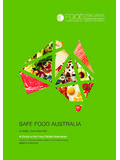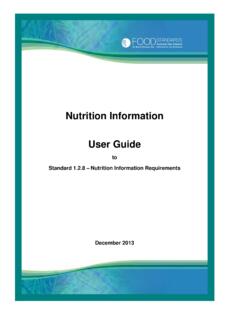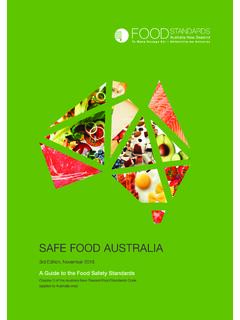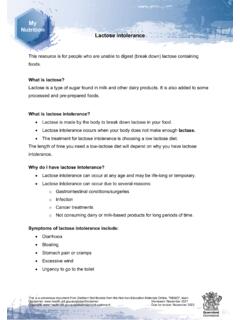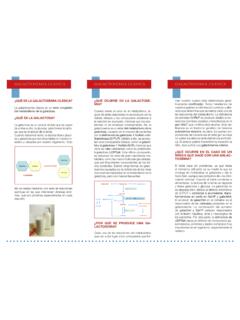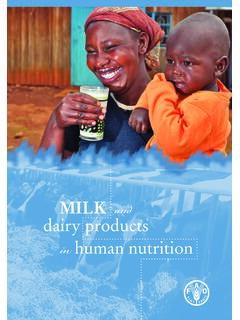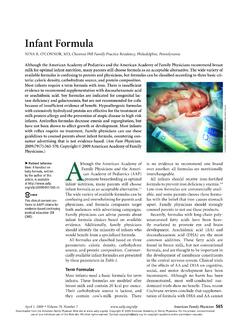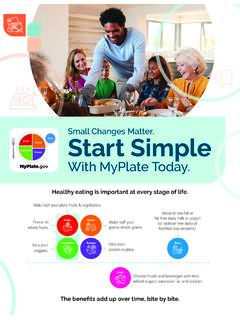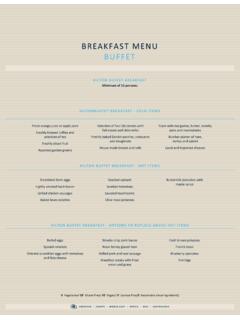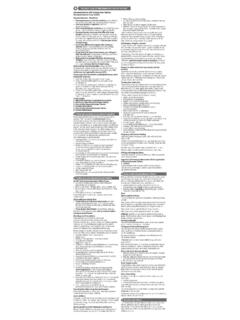Transcription of Schedule 4 Nutrition, health and related claims
1 As at 1 March 2016 1 Schedule 4 Schedule 4 Nutrition, health and related claims Note 1 This instrument is a standard under the Food Standards Australia New Zealand Act 1991 (Cth). The standards together make up the Australia New Zealand Food Standards Code. See also section 3. This Standard, together with Schedule 5 and Schedule 6, relates to Standard (nutrition, health and related claims ), and sets out information for the purpose of that Standard. Note 2 The provisions of the Code that apply in New Zealand are incorporated in, or adopted under, the Food Act 2014 (NZ). See also section 3. S4 1 Name This Standard is Australia New Zealand Food Standards Code Schedule 4 Nutrition, health and related claims .
2 Note Commencement: This Standard commences on 1 March 2016, being the date specified as the commencement date in notices in the Gazette and the New Zealand Gazette under section 92 of the Food Standards Australia New Zealand Act 1991 (Cth). See also section 93 of that Act. S4 2 Definitions In this Schedule : maximum claimable amount means the maximum claimable amount as prescribed by section 4 or 5. reference quantity means the reference quantity specified for the food in the Table to section S17 4. Note In this Code (see section 2): sugars: (a) in Standard , Standard and Schedule 4 (except where it appears with an asterisk as sugars* ) means monosaccharides and disaccharides; and (a) otherwise means any of the following products, derived from any source: (i) hexose monosaccharides and disaccharides, including dextrose, fructose, sucrose and lactose ; (ii) starch hydrolysate; (iii) glucose syrups, maltodextrin and similar products; (iv) products derived at a sugar refinery, including brown sugar and molasses; (v) icing sugar; (vi) invert sugar; (vii) fruit sugar syrup; but does not include: (i) malt or malt extracts.
3 Or (ii) sorbitol, mannitol, glycerol, xylitol, polydextrose, isomalt, maltitol, maltitol syrup, erythritol or lactitol. Note Sugar is defined differently see section 3. Note Sugars* is relevant for claims about no added sugar. S4 3 Conditions for nutrition content claims For subsection 12(1), the table is: Conditions for nutrition content claims Column 1 Column 2 Column 3 Column 4 *Property of food General claim conditions that must be met Specific descriptor Conditions that must be met if using specific descriptor in Column 3 *Carbohydrate Reduced or light/lite The food contains at least 25% less *carbohydrate than in the same amount of *reference food. As at 1 March 2016 2 Schedule 4 Conditions for nutrition content claims Column 1 Column 2 Column 3 Column 4 *Property of food General claim conditions that must be met Specific descriptor Conditions that must be met if using specific descriptor in Column 3 Increased The food contains at least 25% more *carbohydrate than in the same amount of *reference food.
4 Cholesterol The food meets the conditions for a nutrition content claim about low saturated fatty acids. Low The food contains no more cholesterol than: (a) 10 mg/100 mL for liquid food; or (b) 20 mg/100 g for solid food. Reduced or Light / Lite The food contains at least 25% less cholesterol than in the same amount of *reference food. *Dietary fibre A serving of the food contains at least 2 g of *dietary fibre unless the claim is about low or reduced dietary fibre. Good source A serving of the food contains at least 4 g of *dietary fibre. Excellent source A serving of the food contains at least 7 g of *dietary fibre. Increased (a) The *reference food contains at least 2 g of *dietary fibre per serving; and (b) the food contains at least 25% more *dietary fibre than in the same amount of reference food.
5 Energy Low The *average energy content of the food is no more than: (a) 80 kJ/100 mL for liquid food; or (b) 170 kJ/100 g for solid food. Reduced or Light/Lite The food contains at least 25% less energy than in the same amount of *reference food. Diet (a) The food meets the NPSC, unless the food is a special purpose food; and (b) either of the following is satisfied: (i) the *average energy content of the food is no more than 80 kJ/100 mL for liquid food or 170 kJ/100 g for solid food; or (ii) the food contains at least 40% less energy than in the same amount of *reference food. As at 1 March 2016 3 Schedule 4 Conditions for nutrition content claims Column 1 Column 2 Column 3 Column 4 *Property of food General claim conditions that must be met Specific descriptor Conditions that must be met if using specific descriptor in Column 3 Fat % Free The food meets the conditions for a nutrition content claim about low fat.
6 Low The food contains no more fat than: (a) g/100 mL for liquid food; or (b) 3 g/100 g for solid food. Reduced or Light/Lite The food contains at least 25% less fat than in the same amount of *reference food. Gluten Free The food must not contain: (a) detectable gluten; or (b) oats or oat products; or (c) cereals containing *gluten that have been malted, or products of such cereals. Low The food contains no more than 20 mg gluten/100 g of the food. *Glycaemic Index (a) The food meets the NPSC, unless the food is a special purpose food; and (b) the claim or the nutrition information panel includes the numerical value of the *glycaemic index of the food. Low The numerical value of the *glycaemic index of the food is 55 or below.
7 Medium The numerical value of the *glycaemic index of the food is at least 56 and does not exceed 69. High The numerical value of the *glycaemic index of the food is 70 or above. Glycaemic load The food meets the NPSC, unless the food is a special purpose food. lactose Free The food contains no detectable lactose . Low The food contains no more than 2 g of lactose /100 g of the food. Mono-unsaturated fatty acids The food contains, as a proportion of the total fatty acid content: (a) no more than 28% saturated fatty acids and trans fatty acids; and (b) no less than 40% monounsaturated fatty acids. Increased (a) The food contains at least 25% more *monounsaturated fatty acids than in the same amount of *reference food; and (b) the reference food meets the general claim conditions for a nutrition content claim about monounsaturated fatty acids.
8 As at 1 March 2016 4 Schedule 4 Conditions for nutrition content claims Column 1 Column 2 Column 3 Column 4 *Property of food General claim conditions that must be met Specific descriptor Conditions that must be met if using specific descriptor in Column 3 Omega-3 fatty acids (a) The food meets the conditions for a nutrition content claim about omega fatty acids; and (b) the food contains no less than: (i) 200 mg alpha-linolenic acid per serving; or (ii) 30 mg total eicosapentaenoic acid and docosahexaenoic acid per serving; and (c) other than for fish or fish products with no added *saturated fatty acids, the food contains: (i) as a proportion of the total fatty acid content, no more than 28% saturated fatty acids and trans fatty acids; or (ii) no more saturated fatty acids and *trans fatty acids than 5 g per 100 g Good Source (a) The food contains no less than 60 mg total eicosapentaenoic acid and docosahexaenoic acid/serving; and (b) the food may contain less than 200 mg alpha-linolenic acid/serving.
9 Increased (a) The food contains at least 25% more omega-3 fatty acids than in the same amount of *reference food; and (b) the reference food meets the general claim conditions for a nutrition content claim about omega-3 fatty acids. Omega-6 fatty acids (a) The food meets the conditions for a nutrition content claim about omega fatty acids; and (b) the food contains, as a proportion of the total fatty acid content: (i) no more than 28% *saturated fatty acids and trans fatty acids; and (ii) no less than 40% omega-6 fatty acids. Increased (a) The food contains at least 25% more omega-6 fatty acids than in the same amount of *reference food; and (b) the reference food meets the general claim conditions for a nutrition content claim about omega-6 fatty acids.
10 As at 1 March 2016 5 Schedule 4 Conditions for nutrition content claims Column 1 Column 2 Column 3 Column 4 *Property of food General claim conditions that must be met Specific descriptor Conditions that must be met if using specific descriptor in Column 3 Omega-9 fatty acids (a) The food meets the conditions for a nutrition content claim about omega fatty acids; and (b) the food contains, as a proportion of the total fatty acid content: (i) no more than 28% *saturated fatty acids and trans fatty acids; and (ii) no less than 40% omega-9 fatty acids. Increased (a) The food contains at least 25% more omega-9 fatty acids than in the same amount of *reference food; and (b) the reference food meets the general claim conditions for a nutrition content claim about omega-9 fatty acids.


